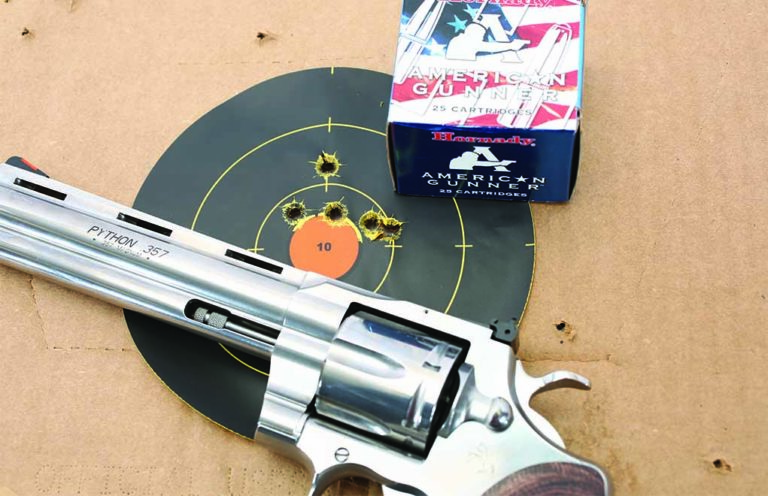
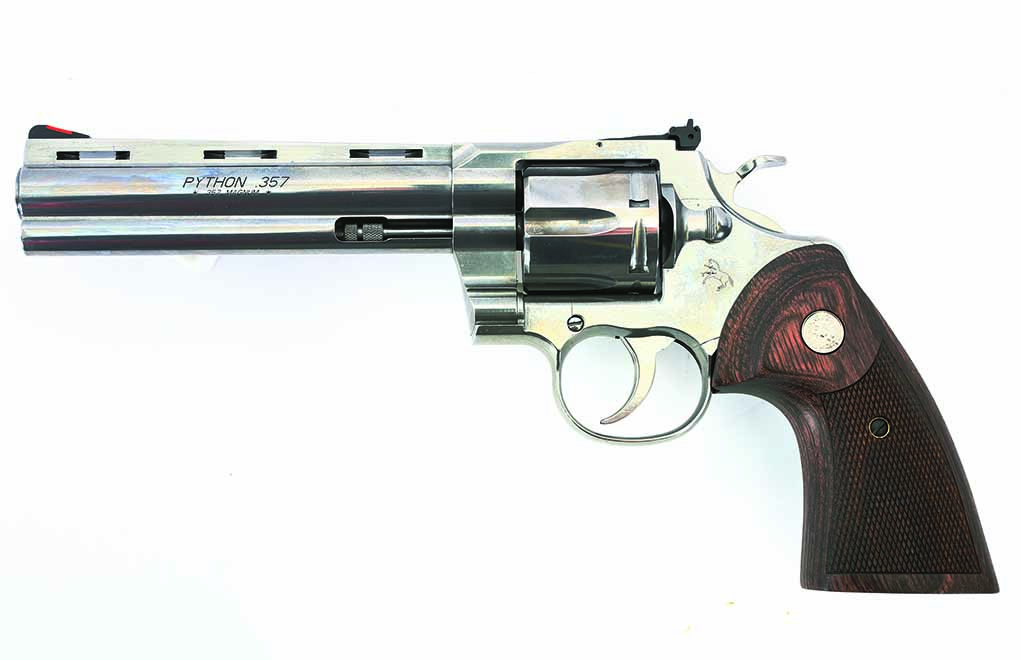
The re-introduction of the Colt Python has been a rollercoaster of excitement and disappointment. So what's the story: is this the second coming or a troubled handgun?
How Does The New Python Differ From The Old:
- Improved stainless steel used in the frame and barrel.
- More cross-section at the rear of the frame for a more resiliant sight base.
- Simplified internals with fewer parts.
- Updated dual-action leaf spring.
- Front sight is user replacable.
The Colt Python was lusted after by many. It was not, however, acquired by many. Part of that was due to the cost, because the Python typically cost twice as much as any other DA revolver of its time. It was first offered by Colt back in the mid-1950s, but the earliest movie reference I can find is from 1969. After that, it was quite the popular option.
Nevertheless, the price put off a lot of shooters; that, and the reputation for being a bit fragile. Even well into the IPSC competition era, not many people who owned .357 Magnums shot a steady diet of .357 magnum-level ammo through any handgun. Most shooters would put a box of magnums through their revolvers once a year. If they shot more, it was more likely that the revolver in question saw mostly .38 Special ammo. The .38s cost less and also hammered your hantds less.
Colt being Colt—that is, a wholly owned subsidiary of one mega-corporation or another—it simply kept on making Pythons and charging what it could … until it just couldn’t do it anymore. And then, Colt stopped making Pythons.
The reaction was immediate. Prices shot up. Unfired Pythons, new in the box, started selling for stupid-high prices. I mean, when you could sell a NIB Python for enough to purchase a well-equipped small car, the 21st century was not turning out the way I’d expected.
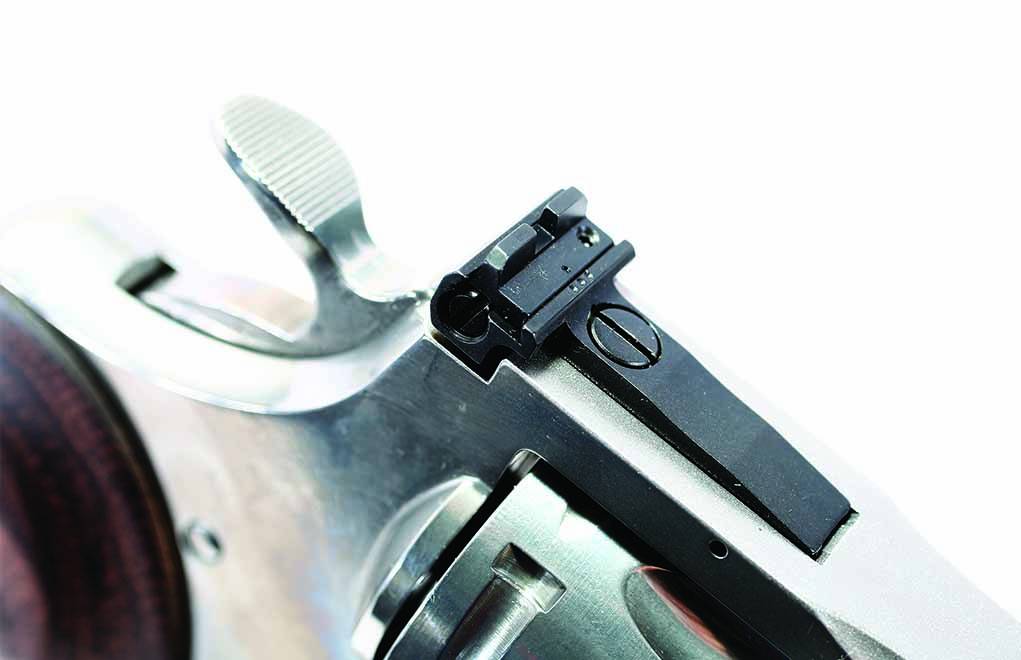
The next step was amazingly un-Colt. The company fired up the AutoCAD and set about making a new Python. I wish Colt had called it that—the “New Python,” I mean. We will, for a long time forward, have to go through the “Who’s on first?” routine of “a new Python or a New Python” to distinguish the new stainless ones made in the 21st century from an unfired one made “back in the day.”
The New Colt Python
Colt selected a new and improved stainless steel and took advantage of the advances in metallurgy since the Chevy Bel Air was the hottest thing from Detroit. It changed the frame at the rear sight to give it a bit more cross-section and to accommodate the new rear sight. That’s a very good thing, because the rear sight on Pythons (and also used in old Gold Cups) was known to be fragile. The new one looks tougher. The front is a red ramp, just like the old ones. However, you can change this one on your own.
The internals have been changed. Colt managed to keep the basics of the Python action, but it dropped the parts number of the lockwork by over a dozen. Fewer parts are usually a good thing. Colt kept the dual-action leaf spring, but it updated it.
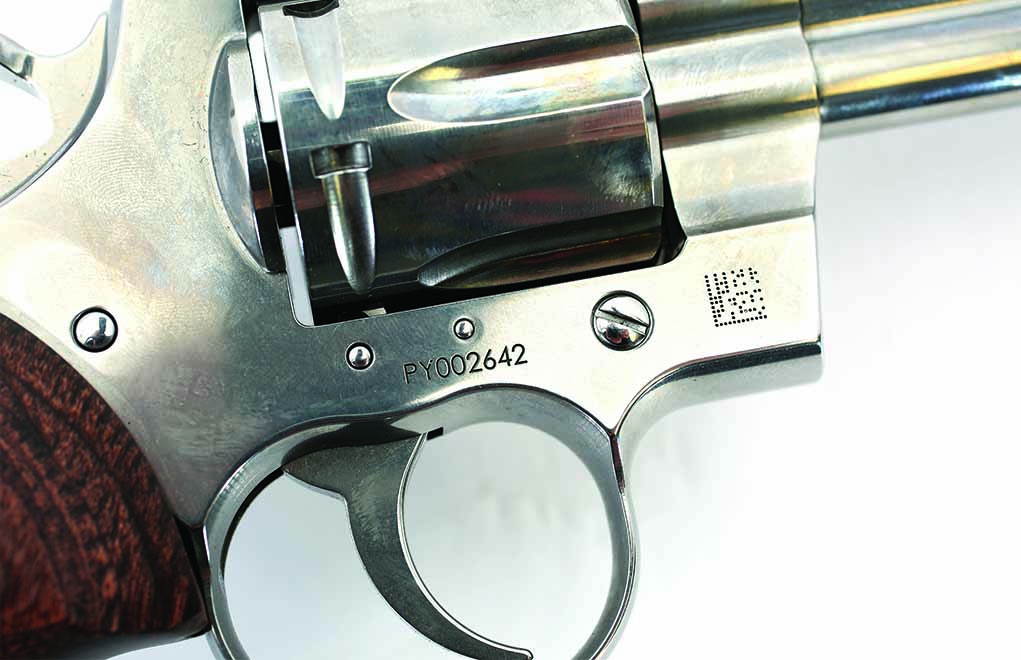
The original used a “V” spring. Properly made, these will last almost forever. British Best shotguns customarily use V springs, and some of those shotguns have recorded hundreds of thousands of rounds without a fault. The problem is, they require skilled workmen to fabricate them, and people with those skills cost money to employ. Worse yet, the Python action required skilled workmen to assemble—and time. I’ve said it before, but it bears repeating: The Python was designed at a time when steel was expensive and skilled labor was cheap. Today, those variables are flipped. As a result, the new Python uses a two-arm spring that isn’t a “V” but a “U” in shape.
Internals
Some of the internals show the hallmarks of MIM fabrication, which, in and of itself, is not a bad thing anymore. It used to be, but isn’t. The end result of the changes is a markedly improved double-action pull.
I had a chance to test the new Python against three classic Pythons, as well as my own 1936-made Official Police—the same frame the Python was built on. The DA on the new Python is much better: The old Pythons had a 9-pound DA (the OP was a bit heavier than that, but it’s also a .22LR and needs a bit more “oomph” to ensure ignition), and the new Python shows a 7-pound DA stroke. Back when I was shooting PPC, I would have put up with the Python cost (and fragile rear sight) to get an out-of-the-box DA of 7 pounds.

Alas, all is not sweetness and light. The single-action pull of the old Pythons and the OP was 3 pounds—clean, crisp and perfect for those wanting to shoot bullseye (which was pretty much the only competition to be found back in 1955, the first year of Python production). The new Python has a 5-pound trigger pull, and it isn’t clean and crisp. However, the bright side of this is that making a single-action trigger pull cleaner and lighter is a whole lot easier (especially with the Python) than doing the same to the DA. So, Colt has done the hard work for us here.
Externals
The externals are much the same, but there are a few improvements. The barrel is the same full, under-lugged design, with the vent rib on top. However, where the originals were just a flat face, the crown is recessed. The front sight on the originals was pinned in place. If you wanted it changed, you needed either a pistol smith or pistol-smithing skills and tools. Now, the front sight is user-changeable.
The ejector rod is the same (the too-short-to-fully-eject length) as the originals. I just have to shake my head. With all the extras Colt put in, couldn’t it have made the ejector rod longer enough to at least make sure .38 Special cases would clear the star?
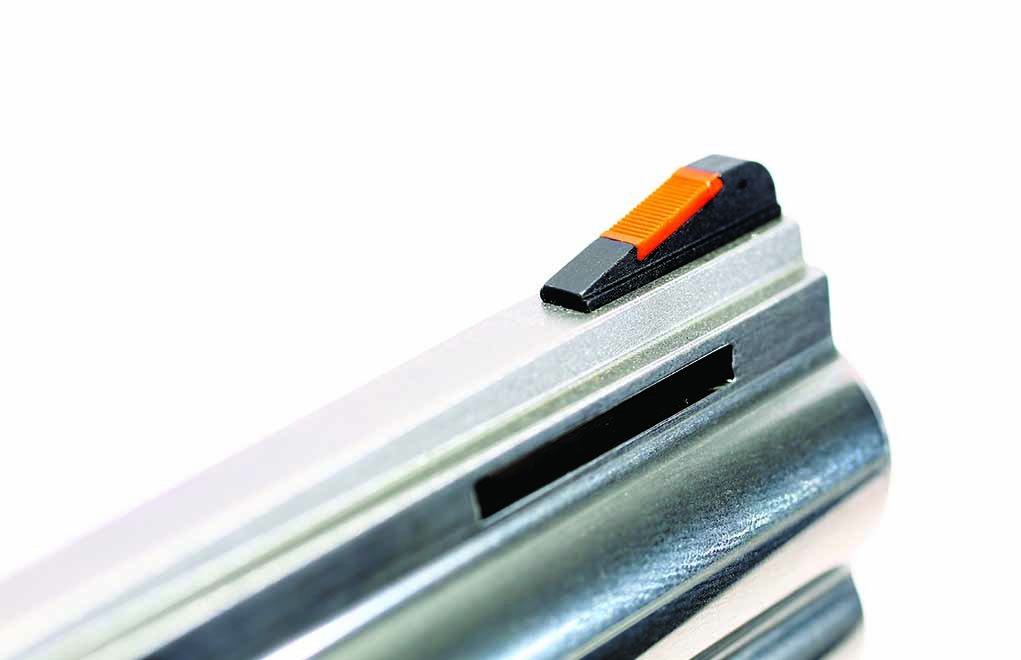
The six-shot cylinder still has the locking slots cut off center to allow for the thickest possible chamber wall. The action is still timed so the instant the cylinder locks up, the hammer falls.
Colt also went with a set of walnut stocks; it calls them “target” stocks. They do look good, and they do feel good in the hand … at first, anyway, for me. There’s a sculpting line on the upper rear of the grips to make the lines clean, smooth and flowing. It’s also a line that puts an edge right at the heel of my thumb. My grip is not like most. I choke up on a revolver to the point that the hammer brushes my hand in DA shooting. That sculpting line hammers my hand on every shot. So, I have to either hold lower, wear gloves … or swap grips.
With .38s, the Python is a pussycat. Of course, with 42 ounces of steel behind it, how much recoil can a .38 Special produce? Even a +P one? And, as I mentioned before, that’s what most shooters would put through their Pythons back then—and most probably will today. We, of course, won’t.
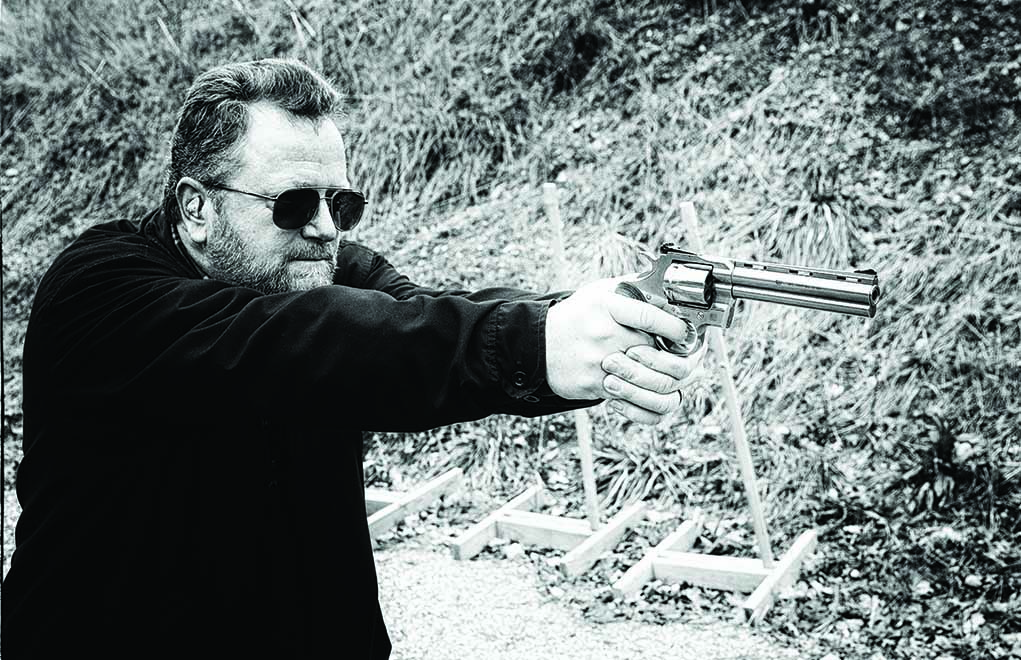
Now, when the Python—the new Python—came out, there were a few people who promptly broke them. (For a change, that wasn’t me.) Word spread that the new Python had some dodgy part or parts, and they would break if you looked at them cross-eyed. Oh, really?
Becoming a Believer
After I did the expected testing and shooting, I dug into the ammo bunker and came up with a pile of .38 and .357 ammo. And a pair of gloves.
I figured that on a range trip, I’d shoot as much .357 as I could stand and then switch to .38s. I’d see if I could break the Python (hey, it was a loaner, so we needed to know, right?). Well, I failed. The Python shot just fine and perked right along through all the ammo I tested in it.
To find out what was up, I asked my source at Colt, Justin Baldini. Out of the 4,000-plus Pythons shipped to date, Colt has had fewer than 10 returned for a functional issue. So much for the pants-wetting hysteria of Internet “experts.” Additionally, the company’s had about 40 returned for cosmetics (mostly of them because some people were unhappy with the crowning treatment).

Now, the ammo I tested I grabbed off the shelf as a cross-section of likely ammo that end-users might choose. I chose the Hornady because it’s soft-shooting and accurate, and you could shoot it all day and not work up a sweat. The high-velocity crowd will be pleased with the Super Vel, because if you have to get a .357-inch bullet there as quickly as possible, this is the one. For those who want to practice for defensive, 125-grain JHPs, the Sig load will replicate the recoil and muzzle blast they produce. And for hunters? Yes—Hornady FTX LeveRevolution is “rifle” ammo. However, if you want to use a .357 Magnum for hunting, this load, in the Python, is going to work well.

Sure, the corner on the grips pounded me, even through the gloves, but that’s what gloves are for. And were I to keep this Python, I’d find grips that fit me better. This one is going back to Colt in due time, because I got the “gotta-have-a-Python” bug out of my system a long time ago.
But that doesn’t mean you have to pass up one of them. Turn off the Internet video, go out and handle one at a gun shop near you. Once you stroke through the DA trigger pull, you’ll be a believer.
Colt Python Specs:
Type: Double-action revolver
Caliber: .357 Magnum
Capacity: 6 rounds
Barrel: 4.25-in. or 6-in.
Length: 9.75 in.
Weight: 42 oz.
Trigger: 5 lb. (SA); 7 lb. (DA)
Finish: Polished stainless steel
MSRP: $1,499
For more information on the Colt Python, please visit colt.com.
The article originally appeared in the June 2020 issue of Gun Digest the Magazine.
Find Out More About Iconic Colt
- Classic Colt Guns
- Colt 1911
- Colt Python
- Colt Cobra
- Colt Single Action Army
- Colt Defender
- Colt M4
- Colt Delta Elite
- Colt 1903
- Colt 1908
- Colt Commander
- Colt AR15A4
- Colt King Cobra
- Colt Competition
- Colt Gold Cup
- Colt M16A1
- Colt Combat Unit Carbine

Next Step: Get your FREE Printable Target Pack
Enhance your shooting precision with our 62 MOA Targets, perfect for rifles and handguns. Crafted in collaboration with Storm Tactical for accuracy and versatility.
Subscribe to the Gun Digest email newsletter and get your downloadable target pack sent straight to your inbox. Stay updated with the latest firearms info in the industry.

![Best Concealed Carry Guns In 2025 [Field Tested] Wilson Combat EDC X9S 1](https://gundigest.com/wp-content/uploads/Wilson-Combat-EDC-X9S-1-324x160.jpg)


![Best 9mm Carbine: Affordable PCCs [Tested] Ruger Carbine Shooting](https://gundigest.com/wp-content/uploads/Ruger-Carbine-Shooting-100x70.jpg)
![Best AR-15: Top Options Available Today [Field Tested] Harrington and Richardson PSA XM177E2 feature](https://gundigest.com/wp-content/uploads/Harrington-and-Richardson-PSA-XM177E2-feature-100x70.jpg)

Based on my experience with the original Python I wasn’t exactly leaping at the opportunity to buy the new and improved version for a thousand bucks more than I paid for my original back in the late ’80s. As with most new entry guns I expected a high MSRP compounded by every rip-off supplier, jobber, and dealer in the county seeking to gouge and indeed I have seen the new model priced over $3,000 by unscrupulous vendors who package the deal with a few boxes of ammo and a holster.
Then I saw Sportsman’s Warehouse was holding the line on pricing at MSRP. Granted we’re used to gun selling for several hundred below MSRP, but considering the market, finding the Python selling for list indicates maybe the asteroid isn’t about to hit!
I paid almost as much for my various S&W X-frames as the Python costs, and the current listed “retail” on my M25-15 New Classic is almost $1,100.00, so $1,499.00 for a brand new, BETTER Python ain’t exactly a bad deal!
Every article and evaluation of the new model centers around Colt’s stated mission to make it stronger, more durable, and able to fire thousands of full-power rounds without any need to be serviced. That’s a tall order, though I seem to remember reading somewhere that Colt has test the new Python over 20,000 rounds of .357 magnum ammo without a failure. if that’s true, then 99.99% of the new Python ownders will have a “forever gun” quite because few shooters fire that number of rounds, and certainly not magnum rounds. Back in the 1960s, ’70s, even ’80s when revolvers were still the predominant handgun choice, most shooters had enough sense to not deliberately abuse their magnum revolvers with a steady diet of such loads because, why? For all intents and purposes MOST who use a revolver for self defense will never notice the difference in recoil, and will be firing in so close that point of aim is irrelevant – as it is every time a u-tube expert engages targets beyond about 10 for REAL LIFE situations!
All this wasting of full power ammo began with the auto crowd and it makes sense there because autos are generally far less powerful, kick out their empties which means they also kick out the HEAT before it’s dumped into the gun’s steel, and require ammo powerful enough to cycle the action when the gun is held with a soft grip.
Having said all that, after Know-nothing shooters shot the S&W M19 to pieces, S&W countered with the L-frame and solved that problem. Nobody has ever shot a M28, or M27 to pieces. I’ve never seen any Ruger DA revolvers shot to pieces either, and now that Colt has moved into the 21st with their NEW line of revolvers, I suspect we shall all see extremely durable revolvers with the rampant Colt on the side!
The gun is a joke. Its lock work was changed to cheapen it and it now has a single action pull twice as heavy as that of the original. Its internal parts are junk MIM castings known for a high failure rate and rough gritty trigger pulls. The gun has already been plagued with malfunctions and a recall. Like most gun companies rather than spend a few pennies and actually test a new design before pawning it off on the public they let the public test it for them and then have endless recalls usually for up to two years. I predict this turkey will not last more than 1 year. Colt will find out the public is not a dumb as they perceive them to be. I personally would not give $300 bucks for this joke of a gun. Ruger .357’s may be crudely made but at least they do not have recalls and they are much lower in price.
You do not know what you are talking about! Also, it would appear your predictions are flat out wrong as the python sales have remained strong in 2021.
The new pythons are actually better than the originals due to advanced CNC Machines.
So don’t hate on the new python because it’s out of your price range 🙂
A little research into the modern process of metal injection molding and the powdered steels used reveals such parts to be superior to those hot cast, complete with stress points and large grain structure. I find it instructive that virtually all modern knife blades are made using the MIM process and high-tech steels to produce blades are stronger, with better edge-holding than anything ever hammered on a forge.
As I type this it’s October of 2021 and Pythons are still being snapped up as fast as they appear. I have my own prediction for the gun snobs, the price of original Pythons will drop as more New Pythons find their way into circulation, and shooters discover the new model is indeed far superior to the original with none of it’s weaknesses and quirks. Only the most premium examples will hold value, but anyone who forked over $2,000 for a shooter grade original Python will never sell it for that based on the nostalgia factor. I own a 4″ barrel original and the new 4.25″ barrel model and there is no comparison. The new model is the better gun! The DA pull is lighter, far smoother and without stacking. The SA pull is glass-rod crisp regardless of the measured pull weight, and in the modern world, DA shooting is preferred over SA – unlike in the good old days.
With a current MSRP of $1,499.00 the new Python is actually not that far above its competitors in the S&W line up, and with shooters reporting thousands of rounds fired without a hitch or issue, the new Python is poised to attract the buyer who was eyeing a M686 at $1,000 then suddenly sees and samples the Python at $1,499.00, and reputable dealers are holding the line on that price.
To compare any Ruger to the Python shows just how completely ignorant you are of firearms. The only joke I see here is YOU. Now put your dunce cap back on and go sit in your corner.
This guy is just angry because he can’t afford one. I own several revolvers Colt, Smith, Ruger and Dan Wesson. All are good guns and shooters. The new Colt Python has an impressive double action that exceeds the earlier Colt Pythons, the single action is good but not better than the S&W 686. The accuracy on the new Python is just as good as the old Python if not better. All in all it is a great gun that will last a lifetime if taken care of.
This new Python was a good idea but soon after the launch, too many buyers started complaining about that it didn’t resemble the old one 100%. I felt that their gripes were over exaggerated and had very little merit.
I acknowledge that many gun owners have absolutely NO technical acumen and probably need a gunsmith to fit new grips.
The real problem is that the new snake was sold out in record time and the re-sales on Gunbroker, etc saw their prices equal or surpass the old Python prices – who in turn are – or will soon be stratospherically high.
Lucky are the ones who own the old snakes. Lucky are the ones who own the new versions – but please – stop moaning about them.